HITLER, MUSSOLINI INK BLOOD PACT
Berlin, Germany · May 22, 1939
On this date in 1939 Nazi Germany and Fascist Italy signed the “Pact of Steel,” which tied the two dictatorships in a ten-year military alliance and stipulated that neither side could make peace without the other’s consent. Ominously dubbed the “Pact of Blood” in the planning stage, the alliance marked the formal creation of the Rome-Berlin Axis, simultaneously giving Italian strongman Benito Mussolini an ally sympathetic to his imperial ambitions in the Balkans and East Africa and Nazi dictator Adolf Hitler the ability to respond to policies of encirclement directed against his country by the Western democracies—Great Britain, France, and Poland.
Mussolini had rejected a formal alliance several times earlier and was nervous even now: at the very moment, Hitler was beginning to confront Poland over the “problem of German-speaking Danzig” (now Gdańsk) and freedom-of-transit issues through the “Polish Corridor,” the post-World War I creation that gave Poland access to the Baltic Sea while it split German Prussia in two. (Before World War I Poles lived in a nation partitioned between Austro-Hungary, the German Empire, and the Russian Empire.) Even after Germany had solved its Polish problems by wiping Poland off the map in September 1939, it wasn’t until June 10, 1940, when German victory in France, Belgium, and the Netherlands was beyond doubt, that Italy owned up to its treaty obligations and entered the conflict by declaring war on France and Great Britain.
For the predatory Mussolini and his nation, June 10 was a tragic misstep. Poor planning would soon cause Italian defeats in Greece, while Axis campaigns in Africa and the Soviet Union shattered the Italian military. Following the July 1943 Allied invasion of Sicily, Italy (Operation Husky), Mussolini was ousted from power and jailed. Hitler reacted with a vengeance, rescuing Mussolini from his detention and occupying the northern half of Italy, where he installed Mussolini at the head of the puppet Repubblica Sociale Italiana (RSI). The south was governed by monarchist and liberal forces that fought on the side of the Allies, helped by about 350,000 partisans of various stripes who ranged over Fascist and Nazi-occupied Italy. Nearly half a million Italians, combatants and noncombatants, died between June 10, 1940, and May 1945.
![]()
Benito Mussolini’s Italy, 1939–1945, and the Axis Pact of Steel
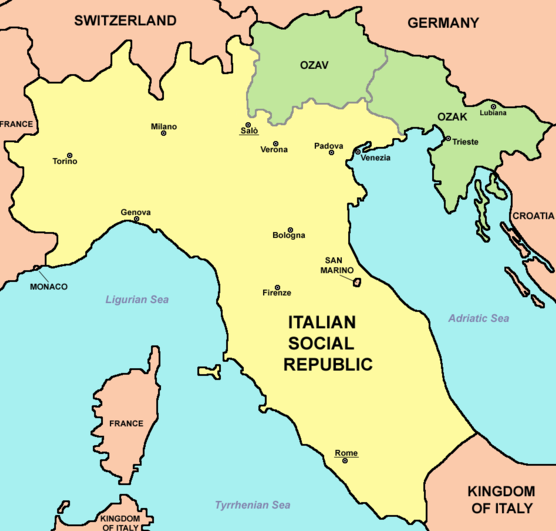 |
Above: Map of Benito Mussolini’s Fascist Italian Social Republic (Repubblica Sociale Italiana [RSI], informally known as “Salò Republic”) in the second half of 1943 (yellow and green). The green-shaded areas in Northeast Italy (Operational Zone Alpine Foothills [OZAV] and Operational Zone Adriatic Coast [OZAK]) were German military zones that were officially part of the RSI, though they were in fact effectively under direct German administration. Mussolini’s seat of government, Salò (underlined), was within miles of the OZAV. Areas to the south of the Italian Social Republic were in the hands of the Western Allies and the post-Mussolini Italian government.
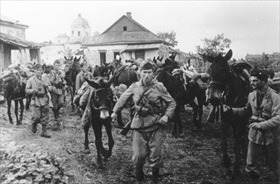 | 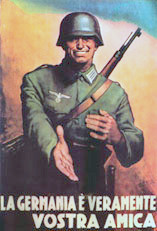 |
Left: Italian soldiers on the Eastern Front, July 1942. At its peak Mussolini’s army contributed 2.5 million troops to the Axis war effort. From the start of the Italian campaign on the Eastern Front in mid-1941 to the Eight Army’s withdrawal in 1943, Italians suffered 75,000 killed; another 54,000 would die in Soviet captivity. Italian ranks had been reduced from a height of 230,000 men in July 1942 to 150,000 men eight months later, and of these 34,000 were wounded. The disaster in Russia (Italian soldiers lacked heavy arms, equipment, ammunition, and provisions), followed swiftly by the rout in North Africa in May 1943 (Axis losses were close to 350,000 in dead and prisoners), sank the Pact of Steel, leading the Grand Council of Fascism in Rome to remove Mussolini as head of government on July 25, 1943.
![]()
Right: A poster from Mussolini’s collaborationist RSI government proclaims “Germany is truly your friend.” After the Wehrmacht ruthlessly disarmed and interned the Italian Army in September 1943 until the end of the war in May 1945 Italian troops fought on both sides: with Mussolini’s National Republican Army (Esercito Nazionale Repubblicano, 52,000 men) or with Marshal Pietro Badoglio’s Allied “Co-Belligerent Forces” (Esercito Cobelligerante Italiano, 50,000 men at its height). In German-occupied Italy (RSI), the partisan movement fielded 350,000 fighters.
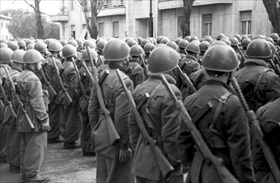 | 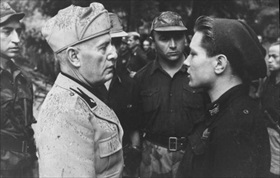 |
Left: Rome, Italy, March 1944. RSI naval commandos being reviewed by a general of the Luftwaffe prior to deployment along the Allied beachhead at Anzio and Nettuno, south of Rome. The commandos, fighting as allies of the Germans, were intensely anti-Semitic in the wake of strong Nazi influence and answered Mussolini’s call to defend the territorial integrity of Italy against the Allies.
![]()
Right: Mussolini speaking to an adolescent member of one of the Fascist paramilitary Black Brigades (Brigate Nere), 1944. The majority of brigade members wore Italian Army ski caps or berets dyed black, replaced their standard-issue Italian Army shirt for a black shirt as a symbol of loyalty to Mussolini, and generally participated in anti-partisan activities. The badge or insignia of the Black Brigades was the jawless death’s head.
Hitler, Mussolini March Lockstep in 1930s German newsreels. German, Italian foreign ministers sign May 22, 1939,“Pact of Steel” in Berlin’s New Reich Chancellery. Begins 11:03 minutes into video
![]()

 History buffs, there is good news! The Daily Chronicles of World War II is now available as an ebook for $4.99 on Amazon.com. Containing a year’s worth of dated entries from this website, the ebook brings the story of this tumultuous era to life in a compelling, authoritative, and succinct manner. Featuring inventive navigation aids, the ebook enables readers to instantly move forward or backward by month and date to different dated entries. Simple and elegant! Click
History buffs, there is good news! The Daily Chronicles of World War II is now available as an ebook for $4.99 on Amazon.com. Containing a year’s worth of dated entries from this website, the ebook brings the story of this tumultuous era to life in a compelling, authoritative, and succinct manner. Featuring inventive navigation aids, the ebook enables readers to instantly move forward or backward by month and date to different dated entries. Simple and elegant! Click 











